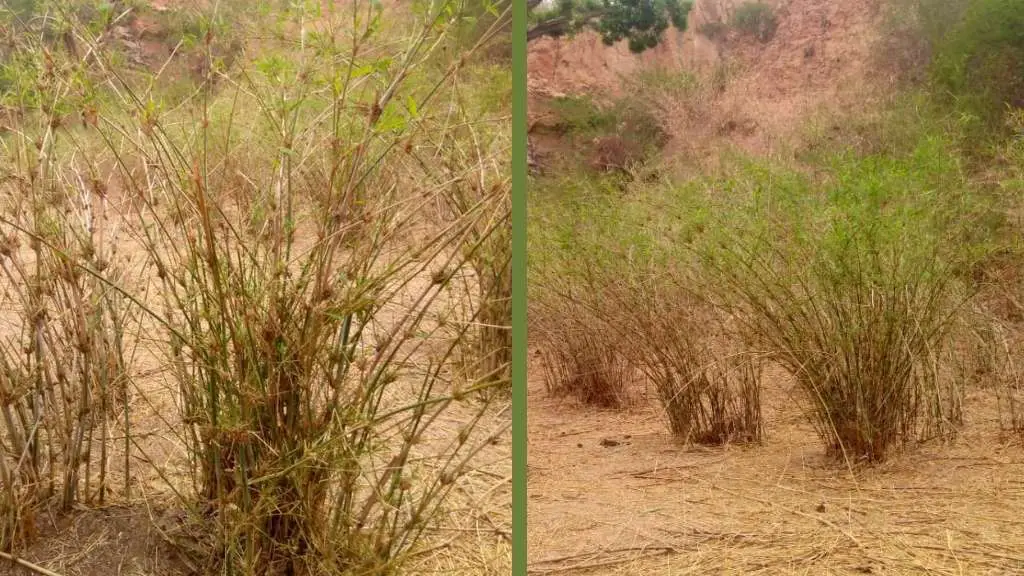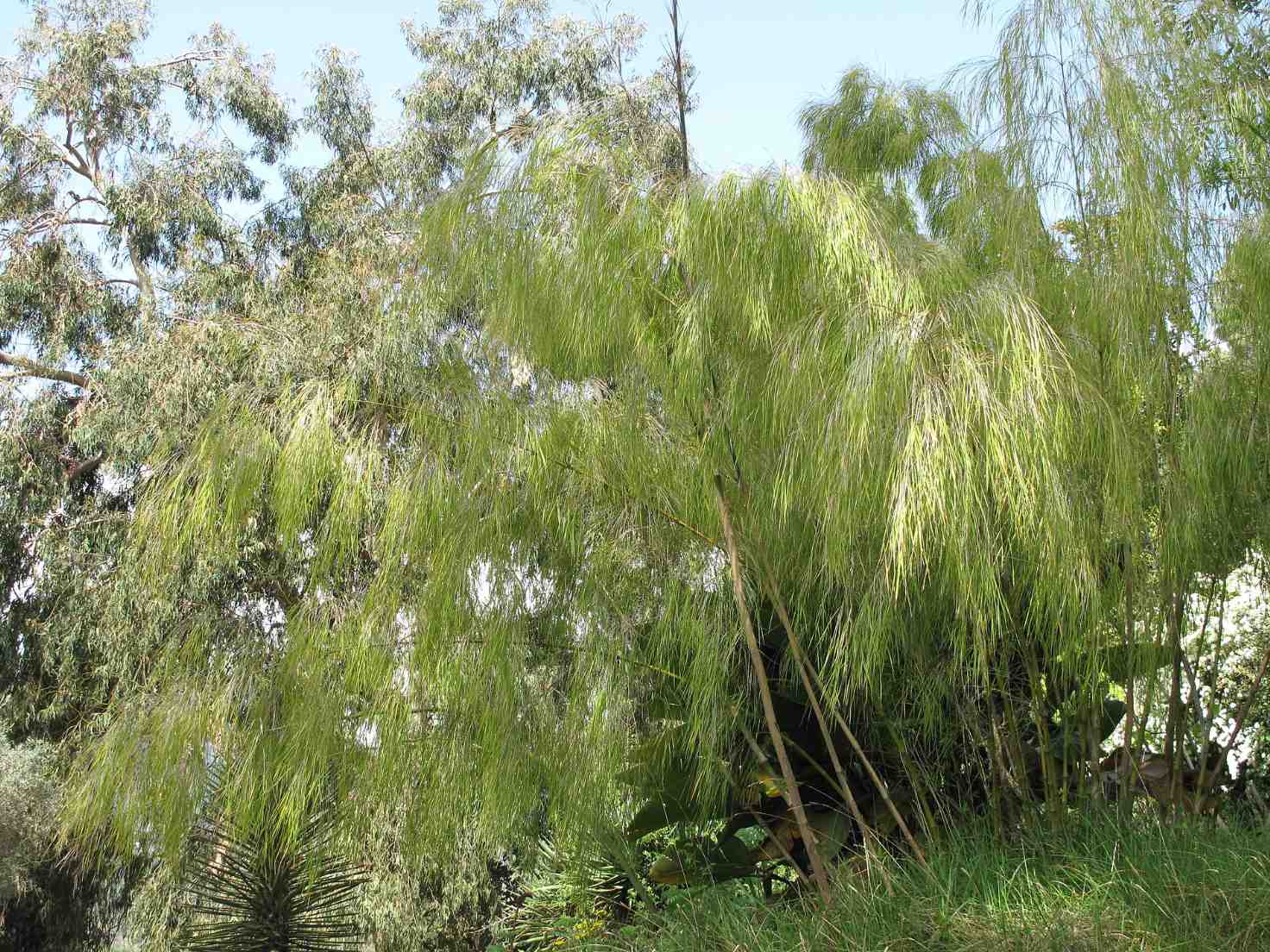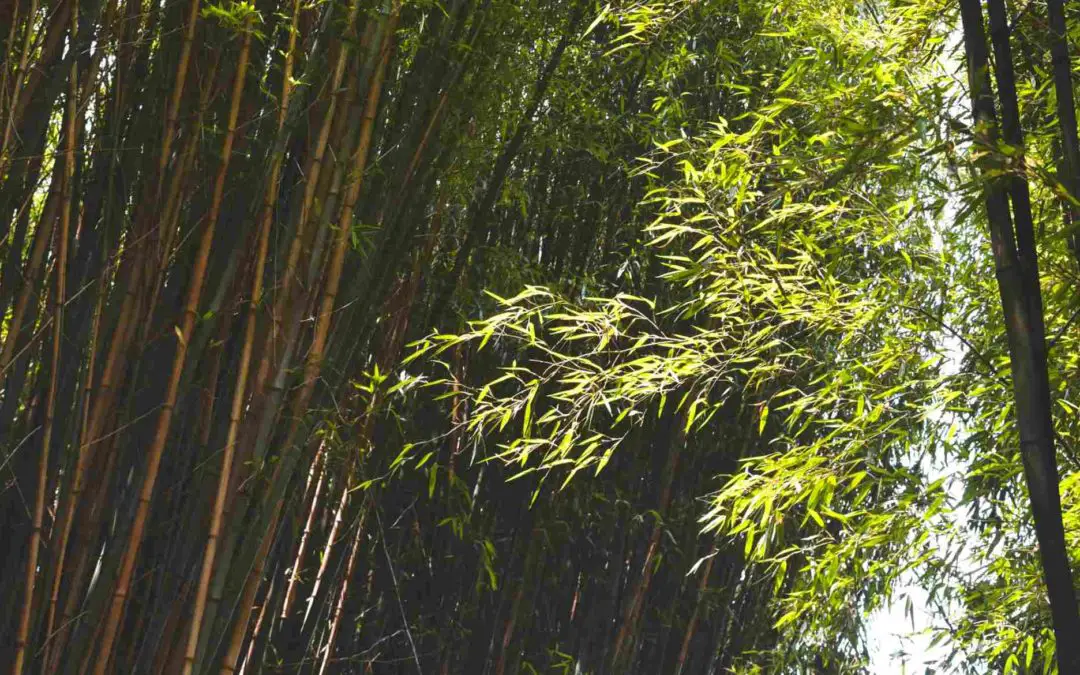With the growing popularity of bamboo, people everywhere are looking for more and more places where they can grow their own bamboo. We generally associate bamboo with the Far East, and especially the tropical jungle zones like Thailand, Bali and the Philippines. But occasionally, someone wants to try growing bamboo in the desert, or in the mountains, or even in Canada.
Is it possible to grow bamboo in the desert?
Bamboo can definitely grow in the desert. Many varieties of bamboo will thrive in the blazing heat. And with its shallow but vigorous roots, bamboo actually requires less water than you’d expect. A healthy grove can help improve the soil, retain moisture, and create better conditions for other plants. At the same time, it will attract some desert wildlife. Just be careful not to plant a shade-loving variety, and be sure to give it water on a regular basis.
Deserts with bamboo
When you look at the distribution of bamboo around the world, you’ll see that the most diversity is clustered around the equator, in places like Indonesia, Southeast Asia, Colombia, and so forth. Most bamboos prefer a climate that’s warm and wet. But of the 1,500 species, there are plenty that thrive in snowy winters at higher elevations or latitudes, and there are others that can withstand the desert.
THE SAHEL
One of the best examples of a desert bamboo species is Oxytenanthera abyssinica. This variety is endemic to sub-Saharan Africa, widespread from Ethiopia to Senegal and all the way to South Africa. It doesn’t actually grow in the Sahara Desert, but it is common in the Sahel, a sensitive transition zone between the desert and the savannah.

As Climate Change and other factors have increased the expansion of the Sahara in recent decades, O. abyssinica stands at the front lines of this environmental crisis. It is a vital species for binding the topsoil, preserving this unique habitat, and thwarting desertification. It is not, however, an ornamental species found in gardens and nurseries.
Bambu Batu is proud to have participated in a research project in Nigeria designed to map the country’s native bamboo resources. In June 2022, researchers identified previously uncharted groves of O. abyssinica in the arid Yobe state of northern Nigeria. They are also studying bamboo’s phytomediation properties, in the context of restoring landscapes spoiled by pollution from the oil industry.
MEXICO
Mexico has a far greater diversity of bamboo than many people realize, including some species native to the country’s dryer northern half. Mexican Weeping Bamboo, for example, can tolerate the blasting sun and a limited water supply. It’s also a popular ornamental variety, especially in southern portions of the US, like Texas and Southern California.
AMERICAN SOUTHWEST
And if you are anywhere near Tucson, Arizona, you can actually visit an amazing bamboo farm. The Bamboo Ranch has over 75 groves of bamboo, down there in the Sonoran Desert. With years of expertise, they specialize in desert-grown bamboo for all uses. Or if you’re in the Southern California desert, look for Christian Lydick’s small bamboo nursery out in El Centro, on Gillett Road.
What about the water supply?
A lot of bamboo growers will tell you not to plant bamboo if you live in the desert. That’s because bamboo requires a lot of water. And by definition, a desert does not have a lot of water. So it’s reasonable to think that bamboo won’t grow in the desert.
But if you’ve ever driven through Palm Springs, you know that they can grow grass in the desert. The acres and acres of emerald green golf courses seem to stretch out forever. Of course, they irrigate those golf courses with mind-boggling quantities of water to keep them looking green. And you could do the same with bamboo. But would you really want to?
How much water does bamboo need?
It’s true that bamboo requires regular water. And that’s why growers will dissuade you from planting it in the desert. But watering regularly is not the same as watering deeply and profusely.
See our in-depth article on Watering your bamboo.
Bamboo is pretty famous for its vigorous rhizome root system. This is what enables bamboo to spread so fast and become difficult to eradicate. But although they can be very aggressive and fast-growing, the roots of bamboo are pretty shallow. That means it only takes a relatively modest amount of water to get the roots really wet.
In the desert, your bamboo will probably need water every other day to stay green and healthy. That may sound like a lot, but it’s not a deep soaking every other day. It’s just a light watering to get the topsoil wet. A few minutes of sprinklers or drip irrigation is usually enough.
That said, you might not want to plant an acre of bamboo in the desert. But if they can farm fruits and carrots in the Imperial Valley, then they can cultivate bamboo just as easily. And they have.
Recycling water
An excellent way to ensure that your bamboo gets enough water is by diverting your household gray water into the garden. In a matter of hours, an experienced plumber or handyman can re-configure some pipes so that the used water from your sinks, showers and dishwasher gets recycled into your bamboo.
Bamboo roots are actually great for filtering dirty water, like the soapy water from the dishwasher or the washing machine. So, for example, you might plant some bamboo above a vegetable garden, and then let the grey water trickle down from the bamboo into the food crops. Even so, you should use eco-friendly soaps and detergents if you decide to do this.
Desert barriers for bamboo
One of the top reasons why people choose not to plant bamboo is its notorious reputation for spreading invasively. It’s true that some species of running bamboo can really take over. As long as there’s good, moist soil, bamboo will happily expand.
The desert, therefore, is able to provide a natural barrier against spreading bamboo. If you’re careful about where you water, you can effectively keep the bamboo in its place. Dry desert sand is not an enticing setting for those grassy rhizomes.
Why does bamboo need less water than other grasses?
Bamboo is a grass, a fairly close cousin to the ground cover you see on golf courses and front yards. But it is far more resilient. Because bamboo grows tall and bushy, it can provide itself with a lot of shade. Unlike the short grass of a well-kept lawn, the sun is not shining directly on the dirt.
Bamboo also drops a lot of leaves, providing itself with a nice layer of mulch. So between the mulch and the shade, the soil under the bamboo is able to retain moisture far better than an ordinary area of grass.
By creating shade, holding the topsoil together, and providing shelter from the dry winds, bamboo can actually be a very practical and beneficial plant in a desert landscape. It may take a couple years to get it going, but once it’s established, you can have yourself a beautiful desert oasis.
Can bamboo get too much water?
Yes, it sure can. It’s not likely to happen in the desert, but you can definitely overwater a bamboo plant. As with most plants, it’s important to let the soil dry out thoroughly between waterings. Underwatering is the second leading cause of death among houseplants. But over-watering is the number one cause.
Many people want to plant bamboo in their ponds or in swampy marshlands. There are a few plants that grow well in saturated soil like this. And bamboo does look very attractive around a koi pond. But it will NOT survive underwater.
There is a species of bamboo, Phyllostachys heteroclada, commonly known as water bamboo, or solid stem bamboo. Specialized air canals allow this variety of bamboo to survive underwater, but only for a day or two. So don’t be fooled, it will not survive in a pond.
Best bamboo species for the desert
If you live in the desert and want to grow bamboo, you can start by heading to a local nursery. If they sell bamboo, it’s probably a good species for that climate. But there’s no guarantee. Not every nursery employee is an expert in bamboo, but some of them are. Otherwise, here’s a list of species that some of our friends in the desert have recommended.

- Bambusa blumeana: Thorny Bamboo, as it’s commonly known, is not a very attractive species for ornamental value, but it can produce great quantities of biomass, and it’s extremely drought-tolerant. Conservationists are planting this bamboo variety around the southern limits of the Sahara as a way to defend against the encroachment of the desert.
- Bambusa oldhamii: One of the most popular species of ornamental bamboo. In favorable conditions, this giant clumper can get about 60 feet tall with 4″ diameter culms. Thick culm walls make it a good species for construction too.
- Bambusa vulgaris ‘Vittata’, or Bambusa striata: An unusually attractive species, with mostly yellow culms and irregular green stripes. The poles can grow to about 30-40 feet tall and up to 3 or 4 inches wide, with thick culm walls.
- Bambusa multiplex ‘Alphonse Karr’: Another popular species of ornamental bamboo with bright yellow canes and very beautiful green striping. Dense clumps get 20-30 feet high with slender poles about 1 inch thick.
- Dendrocalamus strictus: A giant variety of timber bamboo, native to South East Asia. Grows in thick clumps and needs warm weather.
- Otatea acuminata: Also known as Mexican weeping bamboo, and native to the warmer climates. This species grows in dense clumps with slender culms and delicate foliage that sways nicely in the breeze. Native to Mexico, many varieties of Otatea tend to be fairly drought tolerant.
- Phyllostachys mannii ‘Decora’: A variety of running bamboo native to southern China and India. It’s accustomed to hot weather and doesn’t require a lot of water.
- Phyllostachys vivax: This temperate timber bamboo can withstand freezing winters, but it’s also very resilient in extreme heat and with limited water supply.
Bamboo in Qatar
Situated on the Persian Gulf at the edge of the Arabian Desert, the tiny nation of Qatar is one of the last places on earth you’d expect to find any bamboo. And indeed, there is no bamboo growing in this hostile, arid environment, where temperatures sometimes exceed 50º C. But the region does have an interesting history of bamboo usage.
Because lumber has always been so scarce here, the local construction consists almost exclusively of stone. They also use some amount of mangrove, which grows along the coastline. But archaeological excavations have unearthed a surprising quantity of bamboo poles and slats in the older buildings, dating back a few centuries.
Whereas bamboo is considered a “poor man’s timber” in many parts of the world, these denizens of the desert actually went to great lengths to obtain bamboo from their trading partners in other parts of the world. Stone construction could only get them so far, and the roofs were especially difficult to complete without bamboo and timber. Here, bamboo became something of a rich man’s resource.
Historical records show that in earlier times, the people of Qatar did a bristling business collecting pearls from the Persian Gulf. Ships from as far away as India and Zanzibar would enter the gulf, and the foreigners were eager to trade sturdy lumber and bamboo for shiny pearls.
From a practical point of view, it seems that the desert people got the far better end of this exchange. They proceeded to use the lumber to build their own fleet of ships. And the bamboo made its way into their strong but lightweight roofs, capable of supporting rooftop gatherings after sunset under the desert stars.
Conclusions
If you live in the desert and want to grow bamboo, then go for it. Most varieties of bamboo will do fine, so long as they get regular water. Don’t go overboard, but give them a drink every two days. In the peak of summer, they may need water every day. After the sun goes down, you can spray the foliage with a hose to get the leaves wet. Just don’t do this under direct sunlight as it can burn the leaves.
You might also want to plant the bamboo in some partial shade. In a place like Phoenix, Arizona, the full exposure of the sun can be pretty intense. Otherwise, just give them a bit of water, and let the leaves pile up around the stems to help insulate the soil and reduce evaporation.
If you have grand plans to start farming bamboo for commercial purposes, the desert might not be the place to do it. A few ornamentals to accent the garden is one thing, but if you want to turn the desert green, you might try planting some Joshua Trees or Saguaro cactus instead. If it’s a full-scale bamboo farm you want, head down to Florida or Georgia, where the humidity is high and the precipitation is plentiful.
To learn more, check out some of these popular articles:
- Growing bamboo at the Salton Sea
- Planting bamboo to increase rainfall
- Best bamboos for gardens
- Bamboos with stripes
- Growing bamboo in wetlands
- Best bamboo nurseries
PHOTO CREDIT: Bamboo in the sunlight (Unsplash)


























Thank you so much for this wonderful article. I live up the hill (3400’) above Palm Springs and I didn’t think there were cold tolerant varieties. I now am on the list for three types that are 15 degree tolerant. Very excited – I have a small farm up here and bamboo would come in very handy for construction. I bought some cut bamboo poles online several years ago and it was crap bamboo, which I spent a lot for.
Actually I should have realized that there are cold tolerant bamboo varieties…..South Korea gets pretty cold in the winter.